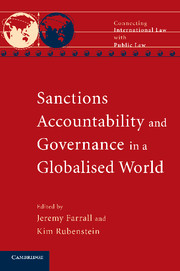Book contents
- Frontmatter
- Contents
- Contributors
- Series editors' preface
- Editors' preface
- Introduction: Filling or falling between the cracks? Law's potential
- PART I Setting down the foundations
- PART II Internationalising public law
- PART III Implementing Security Council sanctions
- PART IV The place of corporations
- PART V The role of lawyers
- PART VI Public law and public policy
- PART VII Parallel case studies
- 15 Discriminating for world peace
- 16 Removing barriers to protection at the exported border: Visas, carrier sanctions and international obligation
- Concluding remarks
- Bibliography
- Index
15 - Discriminating for world peace
Published online by Cambridge University Press: 05 October 2010
- Frontmatter
- Contents
- Contributors
- Series editors' preface
- Editors' preface
- Introduction: Filling or falling between the cracks? Law's potential
- PART I Setting down the foundations
- PART II Internationalising public law
- PART III Implementing Security Council sanctions
- PART IV The place of corporations
- PART V The role of lawyers
- PART VI Public law and public policy
- PART VII Parallel case studies
- 15 Discriminating for world peace
- 16 Removing barriers to protection at the exported border: Visas, carrier sanctions and international obligation
- Concluding remarks
- Bibliography
- Index
Summary
Introduction
Controlling the spread of defence technology is a serious issue for the prospects of peace throughout the world, and for preventing abuses of human rights. Export regulations, which determine who will and who will not have access to defence technology, are a necessary part – but only a part – of that exercise in control. Equally, the principle of non-discrimination is a human right that underpins core human rights instruments. Since September 11, 2001 these two fundamental considerations – security and non-discrimination – have been in relentless tension.
On a mild winter's day in 2003, that tension was played out in Brisbane, Queensland, Australia, where the Anti-Discrimination Tribunal was asked to balance competing claims of national security and non-discrimination. Curiously, the national security at issue was that of the US, not of Australia. In the period since, similar scenes have played out in tribunal rooms and government offices around Australia.
These tribunal proceedings are ostensibly a private matter, where employers seek an exemption from the operation of anti-discrimination legislation to allow them to discriminate not in favour of a minority, as a special measure or affirmative action, but against people's interests, on the basis of their nationality. The employers seek the exemptions because US defence export regulations require an Australian importer of defence technology to engage in unlawful discrimination by singling out workers on the basis of their nationality.
- Type
- Chapter
- Information
- Sanctions, Accountability and Governance in a Globalised World , pp. 355 - 377Publisher: Cambridge University PressPrint publication year: 2009



